cooling DODGE CHARGER SRT 2013 7.G User Guide
[x] Cancel search | Manufacturer: DODGE, Model Year: 2013, Model line: CHARGER SRT, Model: DODGE CHARGER SRT 2013 7.GPages: 599, PDF Size: 4.21 MB
Page 514 of 599
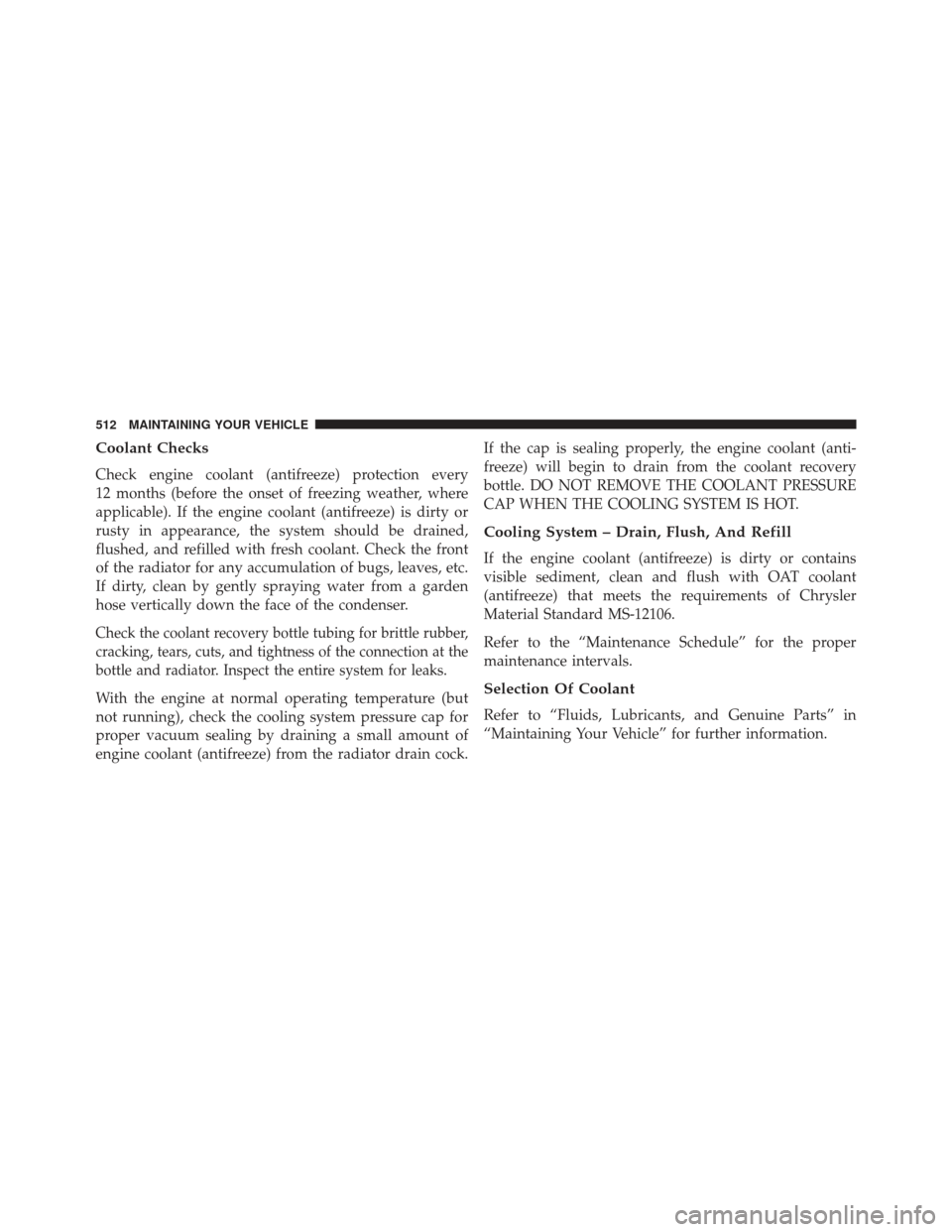
Coolant Checks
Check engine coolant (antifreeze) protection every
12 months (before the onset of freezing weather, where
applicable). If the engine coolant (antifreeze) is dirty or
rusty in appearance, the system should be drained,
flushed, and refilled with fresh coolant. Check the front
of the radiator for any accumulation of bugs, leaves, etc.
If dirty, clean by gently spraying water from a garden
hose vertically down the face of the condenser.
Check the coolant recovery bottle tubing for brittle rubber,
cracking, tears, cuts, and tightness of the connection at the
bottle and radiator. Inspect the entire system for leaks.
With the engine at normal operating temperature (but
not running), check the cooling system pressure cap for
proper vacuum sealing by draining a small amount of
engine coolant (antifreeze) from the radiator drain cock.If the cap is sealing properly, the engine coolant (anti-
freeze) will begin to drain from the coolant recovery
bottle. DO NOT REMOVE THE COOLANT PRESSURE
CAP WHEN THE COOLING SYSTEM IS HOT.
Cooling System – Drain, Flush, And Refill
If the engine coolant (antifreeze) is dirty or contains
visible sediment, clean and flush with OAT coolant
(antifreeze) that meets the requirements of Chrysler
Material Standard MS-12106.
Refer to the “Maintenance Schedule” for the proper
maintenance intervals.
Selection Of Coolant
Refer to “Fluids, Lubricants, and Genuine Parts” in
“Maintaining Your Vehicle” for further information.
512 MAINTAINING YOUR VEHICLE
Page 515 of 599
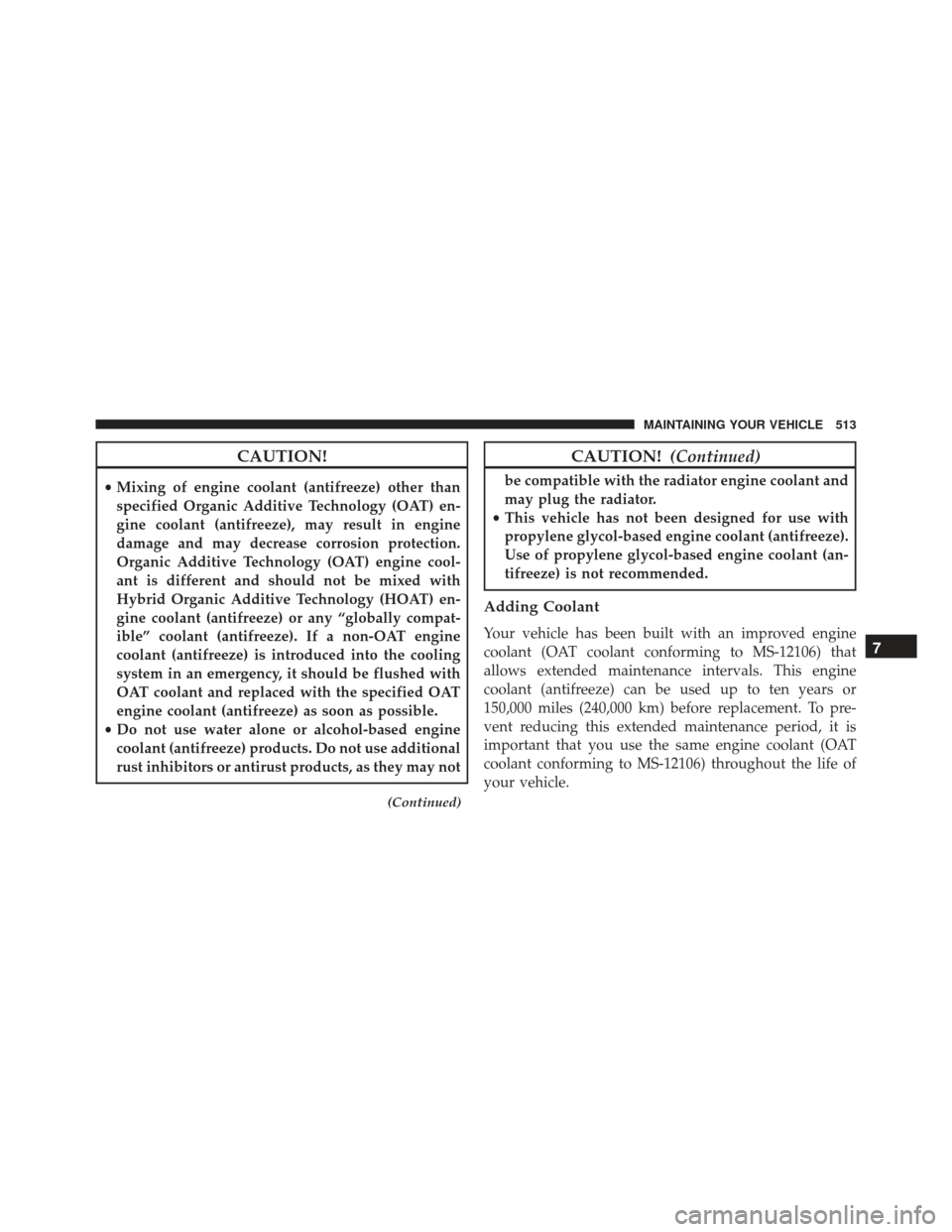
CAUTION!
•Mixing of engine coolant (antifreeze) other than
specified Organic Additive Technology (OAT) en-
gine coolant (antifreeze), may result in engine
damage and may decrease corrosion protection.
Organic Additive Technology (OAT) engine cool-
ant is different and should not be mixed with
Hybrid Organic Additive Technology (HOAT) en-
gine coolant (antifreeze) or any “globally compat-
ible” coolant (antifreeze). If a non-OAT engine
coolant (antifreeze) is introduced into the cooling
system in an emergency, it should be flushed with
OAT coolant and replaced with the specified OAT
engine coolant (antifreeze) as soon as possible.
• Do not use water alone or alcohol-based engine
coolant (antifreeze) products. Do not use additional
rust inhibitors or antirust products, as they may not
(Continued)
CAUTION! (Continued)
be compatible with the radiator engine coolant and
may plug the radiator.
• This vehicle has not been designed for use with
propylene glycol-based engine coolant (antifreeze).
Use of propylene glycol-based engine coolant (an-
tifreeze) is not recommended.
Adding Coolant
Your vehicle has been built with an improved engine
coolant (OAT coolant conforming to MS-12106) that
allows extended maintenance intervals. This engine
coolant (antifreeze) can be used up to ten years or
150,000 miles (240,000 km) before replacement. To pre-
vent reducing this extended maintenance period, it is
important that you use the same engine coolant (OAT
coolant conforming to MS-12106) throughout the life of
your vehicle.7
MAINTAINING YOUR VEHICLE 513
Page 516 of 599
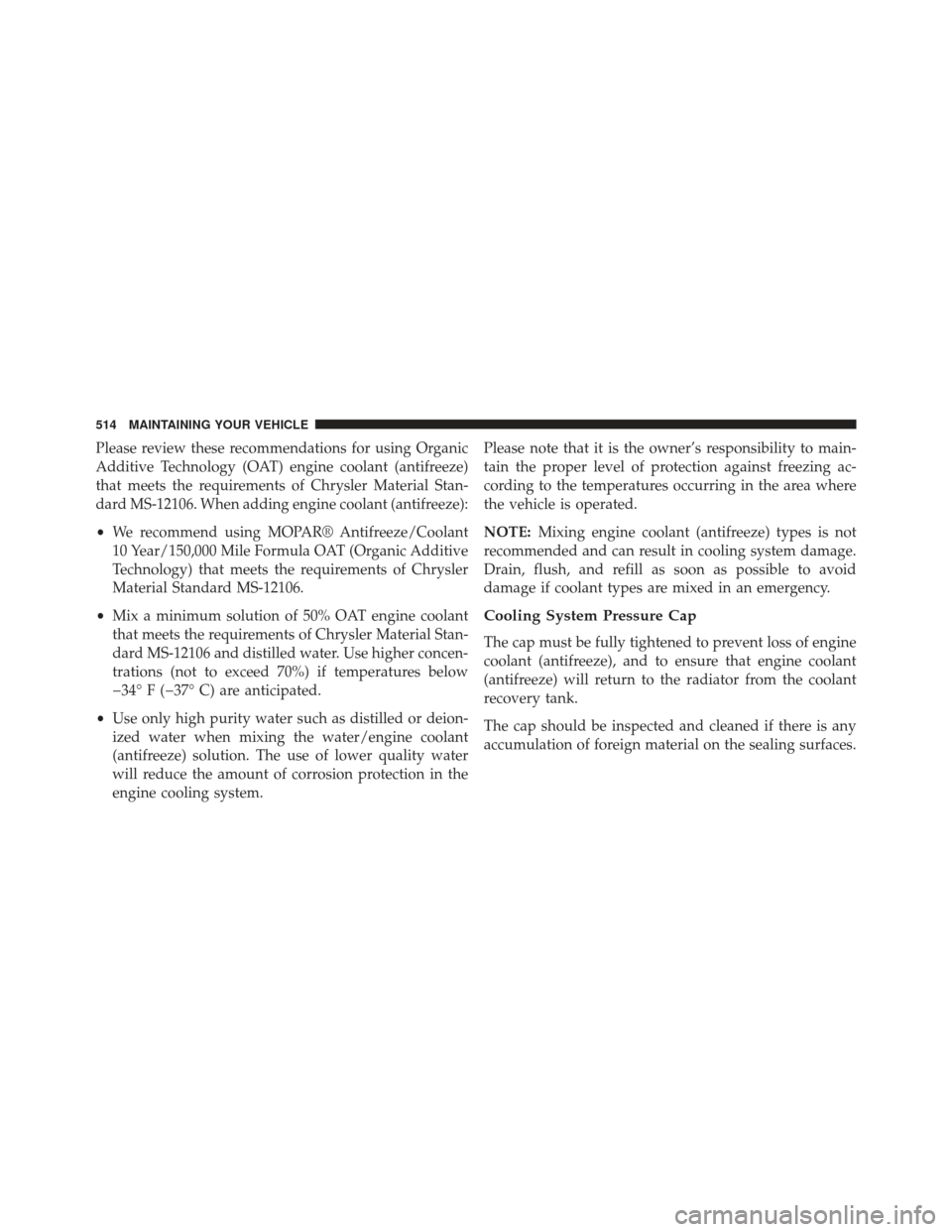
Please review these recommendations for using Organic
Additive Technology (OAT) engine coolant (antifreeze)
that meets the requirements of Chrysler Material Stan-
dard MS-12106. When adding engine coolant (antifreeze):
•We recommend using MOPAR® Antifreeze/Coolant
10 Year/150,000 Mile Formula OAT (Organic Additive
Technology) that meets the requirements of Chrysler
Material Standard MS-12106.
• Mix a minimum solution of 50% OAT engine coolant
that meets the requirements of Chrysler Material Stan-
dard MS-12106 and distilled water. Use higher concen-
trations (not to exceed 70%) if temperatures below
�34° F (�37° C) are anticipated.
• Use only high purity water such as distilled or deion-
ized water when mixing the water/engine coolant
(antifreeze) solution. The use of lower quality water
will reduce the amount of corrosion protection in the
engine cooling system. Please note that it is the owner’s responsibility to main-
tain the proper level of protection against freezing ac-
cording to the temperatures occurring in the area where
the vehicle is operated.
NOTE:
Mixing engine coolant (antifreeze) types is not
recommended and can result in cooling system damage.
Drain, flush, and refill as soon as possible to avoid
damage if coolant types are mixed in an emergency.
Cooling System Pressure Cap
The cap must be fully tightened to prevent loss of engine
coolant (antifreeze), and to ensure that engine coolant
(antifreeze) will return to the radiator from the coolant
recovery tank.
The cap should be inspected and cleaned if there is any
accumulation of foreign material on the sealing surfaces.
514 MAINTAINING YOUR VEHICLE
Page 517 of 599
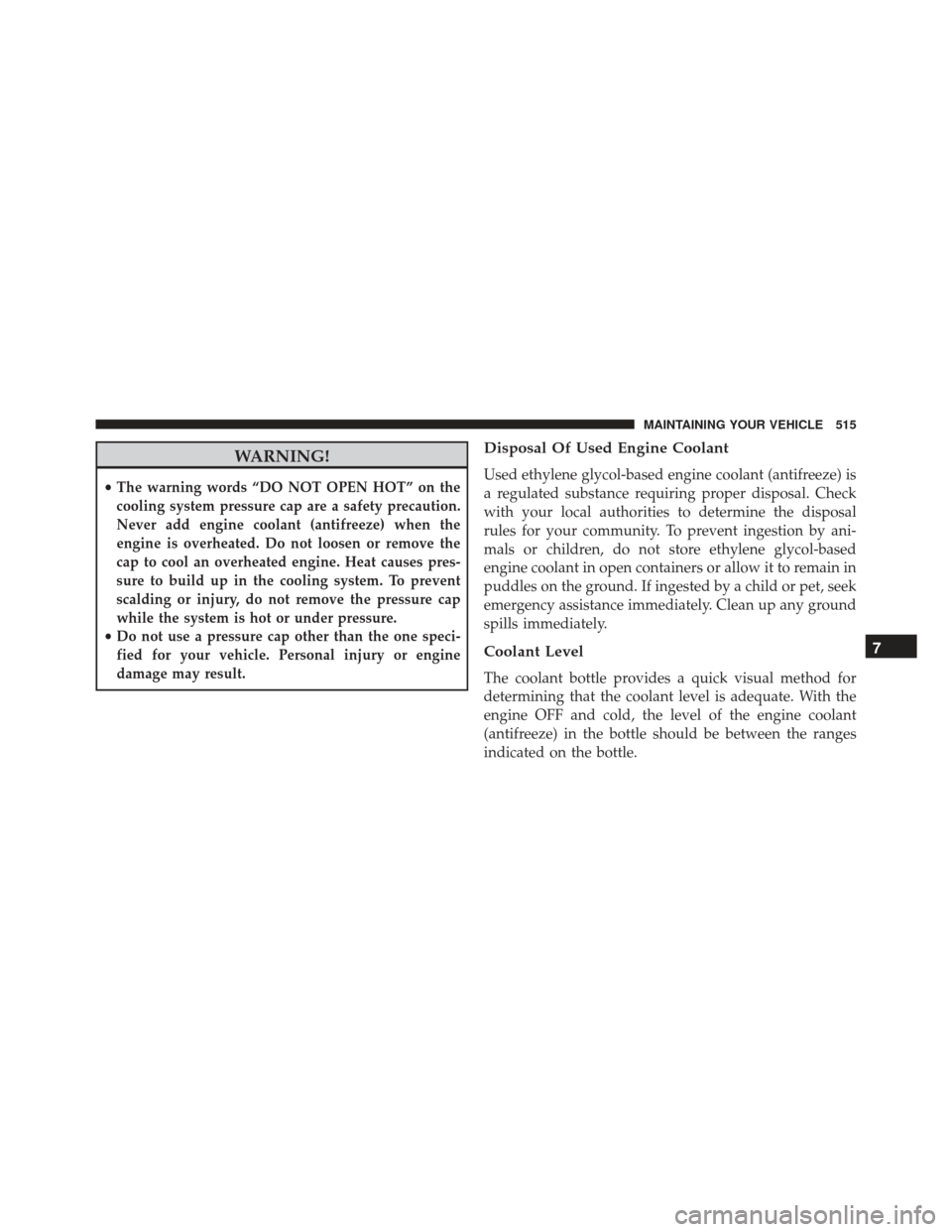
WARNING!
•The warning words “DO NOT OPEN HOT” on the
cooling system pressure cap are a safety precaution.
Never add engine coolant (antifreeze) when the
engine is overheated. Do not loosen or remove the
cap to cool an overheated engine. Heat causes pres-
sure to build up in the cooling system. To prevent
scalding or injury, do not remove the pressure cap
while the system is hot or under pressure.
•Do not use a pressure cap other than the one speci-
fied for your vehicle. Personal injury or engine
damage may result.
Disposal Of Used Engine Coolant
Used ethylene glycol-based engine coolant (antifreeze) is
a regulated substance requiring proper disposal. Check
with your local authorities to determine the disposal
rules for your community. To prevent ingestion by ani-
mals or children, do not store ethylene glycol-based
engine coolant in open containers or allow it to remain in
puddles on the ground. If ingested by a child or pet, seek
emergency assistance immediately. Clean up any ground
spills immediately.
Coolant Level
The coolant bottle provides a quick visual method for
determining that the coolant level is adequate. With the
engine OFF and cold, the level of the engine coolant
(antifreeze) in the bottle should be between the ranges
indicated on the bottle.
7
MAINTAINING YOUR VEHICLE 515
Page 518 of 599
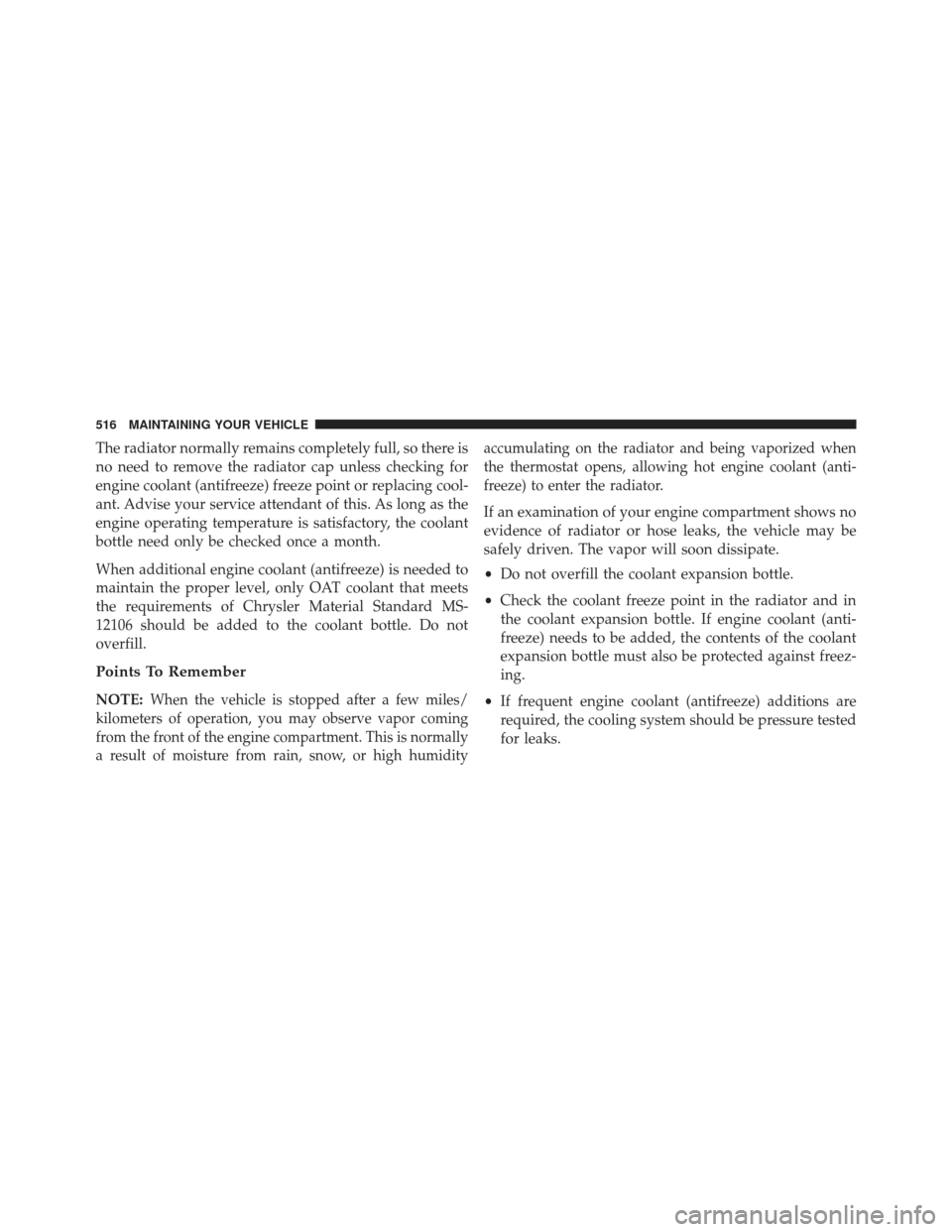
The radiator normally remains completely full, so there is
no need to remove the radiator cap unless checking for
engine coolant (antifreeze) freeze point or replacing cool-
ant. Advise your service attendant of this. As long as the
engine operating temperature is satisfactory, the coolant
bottle need only be checked once a month.
When additional engine coolant (antifreeze) is needed to
maintain the proper level, only OAT coolant that meets
the requirements of Chrysler Material Standard MS-
12106 should be added to the coolant bottle. Do not
overfill.
Points To Remember
NOTE:When the vehicle is stopped after a few miles/
kilometers of operation, you may observe vapor coming
from the front of the engine compartment. This is normally
a result of moisture from rain, snow, or high humidity accumulating on the radiator and being vaporized when
the thermostat opens, allowing hot engine coolant (anti-
freeze) to enter the radiator.
If an examination of your engine compartment shows no
evidence of radiator or hose leaks, the vehicle may be
safely driven. The vapor will soon dissipate.
•
Do not overfill the coolant expansion bottle.
• Check the coolant freeze point in the radiator and in
the coolant expansion bottle. If engine coolant (anti-
freeze) needs to be added, the contents of the coolant
expansion bottle must also be protected against freez-
ing.
• If frequent engine coolant (antifreeze) additions are
required, the cooling system should be pressure tested
for leaks.
516 MAINTAINING YOUR VEHICLE
Page 545 of 599
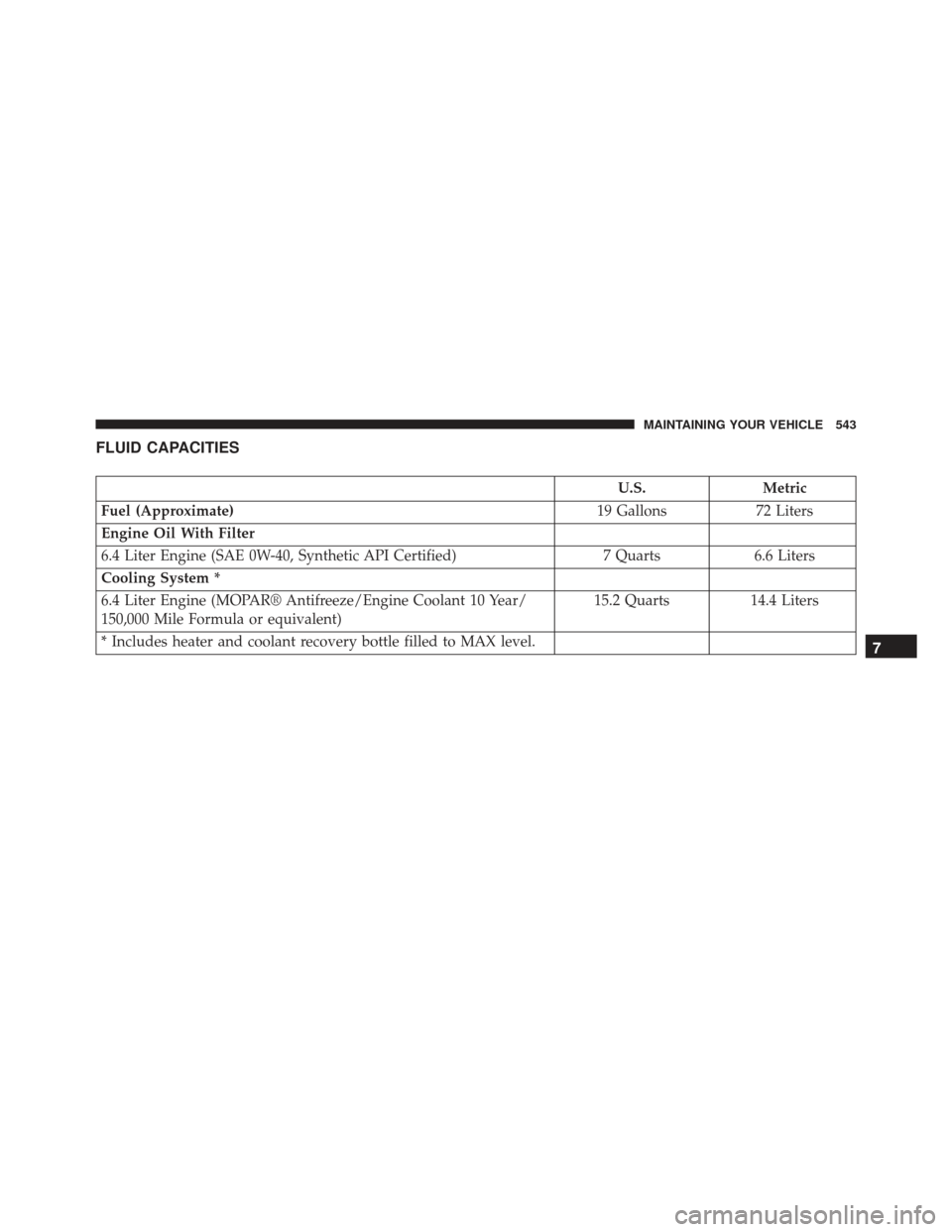
FLUID CAPACITIES
U.S.Metric
Fuel (Approximate) 19 Gallons72 Liters
Engine Oil With Filter
6.4 Liter Engine (SAE 0W-40, Synthetic API Certified) 7 Quarts6.6 Liters
Cooling System *
6.4 Liter Engine (MOPAR® Antifreeze/Engine Coolant 10 Year/
150,000 Mile Formula or equivalent) 15.2 Quarts
14.4 Liters
* Includes heater and coolant recovery bottle filled to MAX level.
7
MAINTAINING YOUR VEHICLE 543
Page 582 of 599
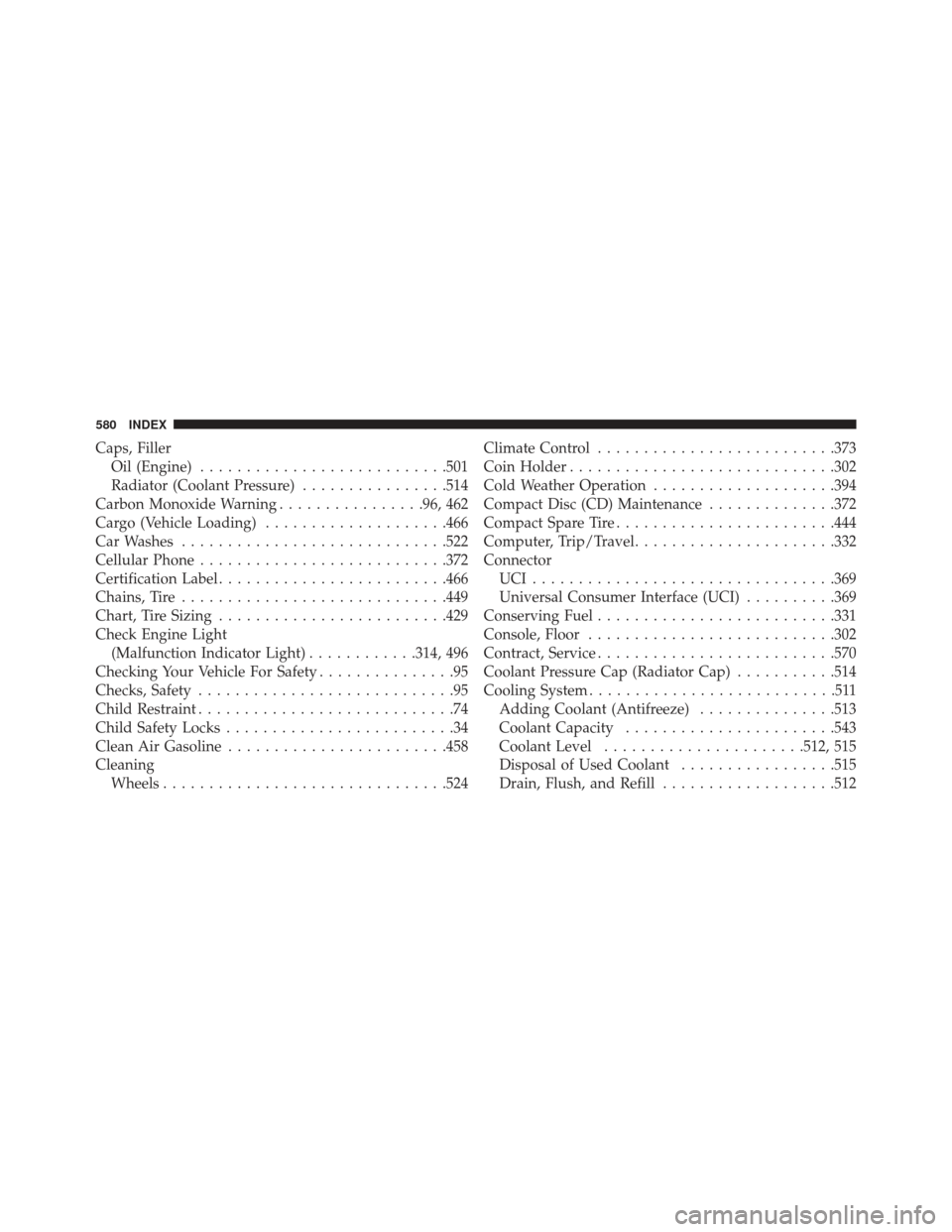
Caps, FillerOil (Engine) .......................... .501
Radiator (Coolant Pressure) ................514
Carbon Monoxide Warning ................96, 462
Cargo (Vehicle Loading) ....................466
Car Washes ............................ .522
Cellular Phone .......................... .372
Certification Label ........................ .466
Chains, Tire ............................ .449
Chart, Tire Sizing ........................ .429
Check Engine Light (Malfunction Indicator Light) ............314, 496
Checking Your Vehicle For Safety ...............95
Checks, Safety ............................95
Child Restraint ............................74
Child Safety Locks .........................34
Clean Air Gasoline ....................... .458
Cleaning Wheels .............................. .524Climate Control
......................... .373
Coin Holder ............................ .302
Cold Weather Operation ....................394
Compact Disc (CD) Maintenance ..............372
Compact Spare Tire ....................... .444
Computer, Trip/Travel ..................... .332
Connector UCI................................ .369
Universal Consumer Interface (UCI) ..........369
Conserving Fuel ......................... .331
Console, Floor .......................... .302
Contract, Service ......................... .570
Coolant Pressure Cap (Radiator Cap) ...........514
Cooling System ...........................511
Adding Coolant (Antifreeze) ...............513
Coolant Capacity ...................... .543
Coolant Level ..................... .512, 515
Disposal of Used Coolant .................515
Drain, Flush, and Refill ...................512
580 INDEX
Page 584 of 599
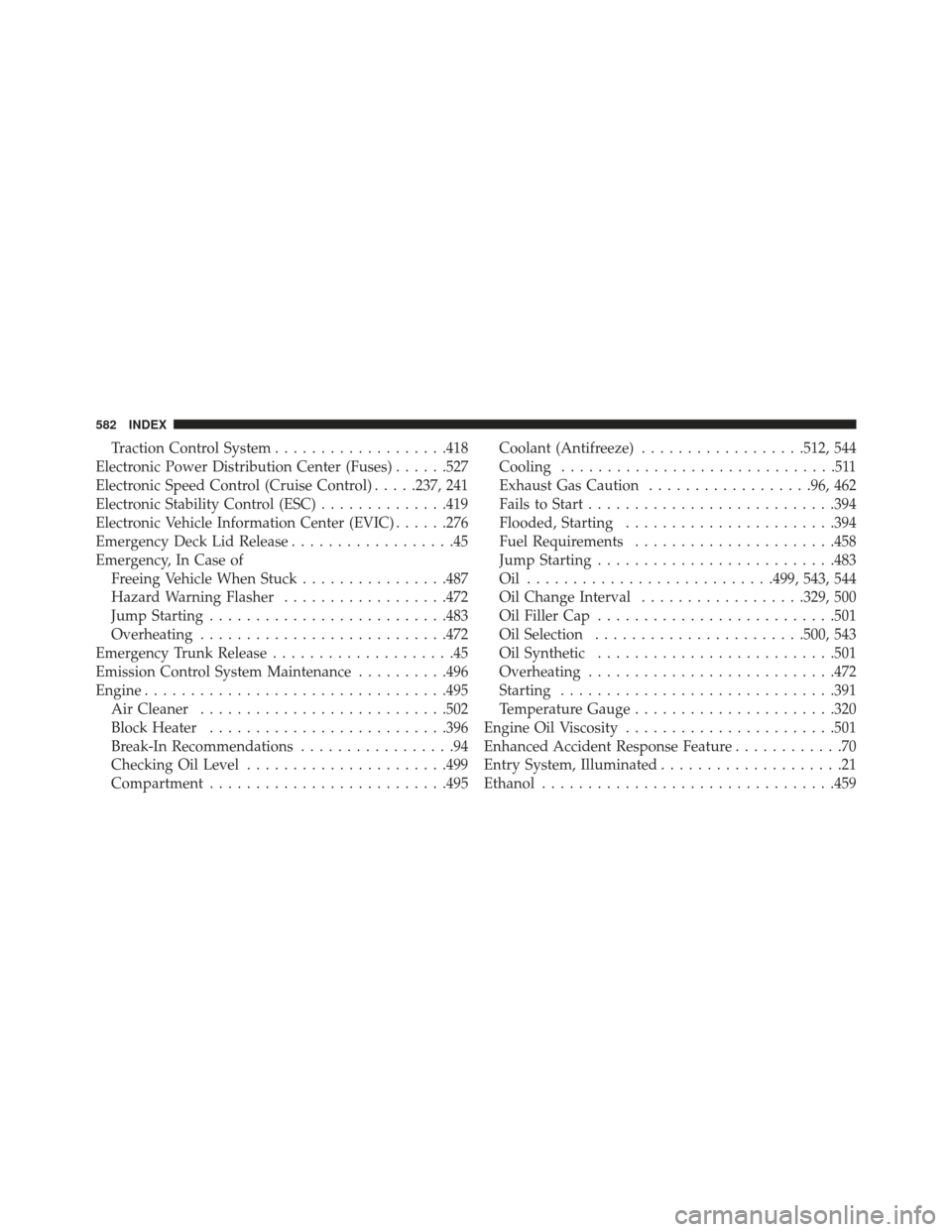
Traction Control System...................418
Electronic Power Distribution Center (Fuses) ......527
Electronic Speed Control (Cruise Control) .....237, 241
Electronic Stability Control (ESC) ..............419
Electronic Vehicle Information Center (EVIC) ......276
Emergency Deck Lid Release ..................45
Emergency, In Case of Freeing Vehicle When Stuck ................487
Hazard Warning Flasher ..................472
Jump Starting ......................... .483
Overheating .......................... .472
Emergency Trunk Release ....................45
Emission Control System Maintenance ..........496
Engine ................................ .495
Air Cleaner .......................... .502
Block Heater ......................... .396
Break-In Recommendations .................94
Checking Oil Level ..................... .499
Compartment ......................... .495Coolant (Antifreeze)
..................512, 544
Cooling ..............................511
Exhaust Gas Caution ..................96, 462
Fails to Start .......................... .394
Flooded, Starting ...................... .394
Fuel Requirements ..................... .458
Jump Starting ......................... .483
Oil .......................... .499, 543, 544
Oil Change Interval ..................329, 500
Oil Filler Cap ......................... .501
Oil Selection ...................... .500, 543
Oil Synthetic ......................... .501
Overheating .......................... .472
Starting ............................. .391
Temperature Gauge ..................... .320
Engine Oil Viscosity ...................... .501
Enhanced Accident Response Feature ............70
Entry System, Illuminated ....................21
Ethanol ............................... .459
582 INDEX
Page 585 of 599
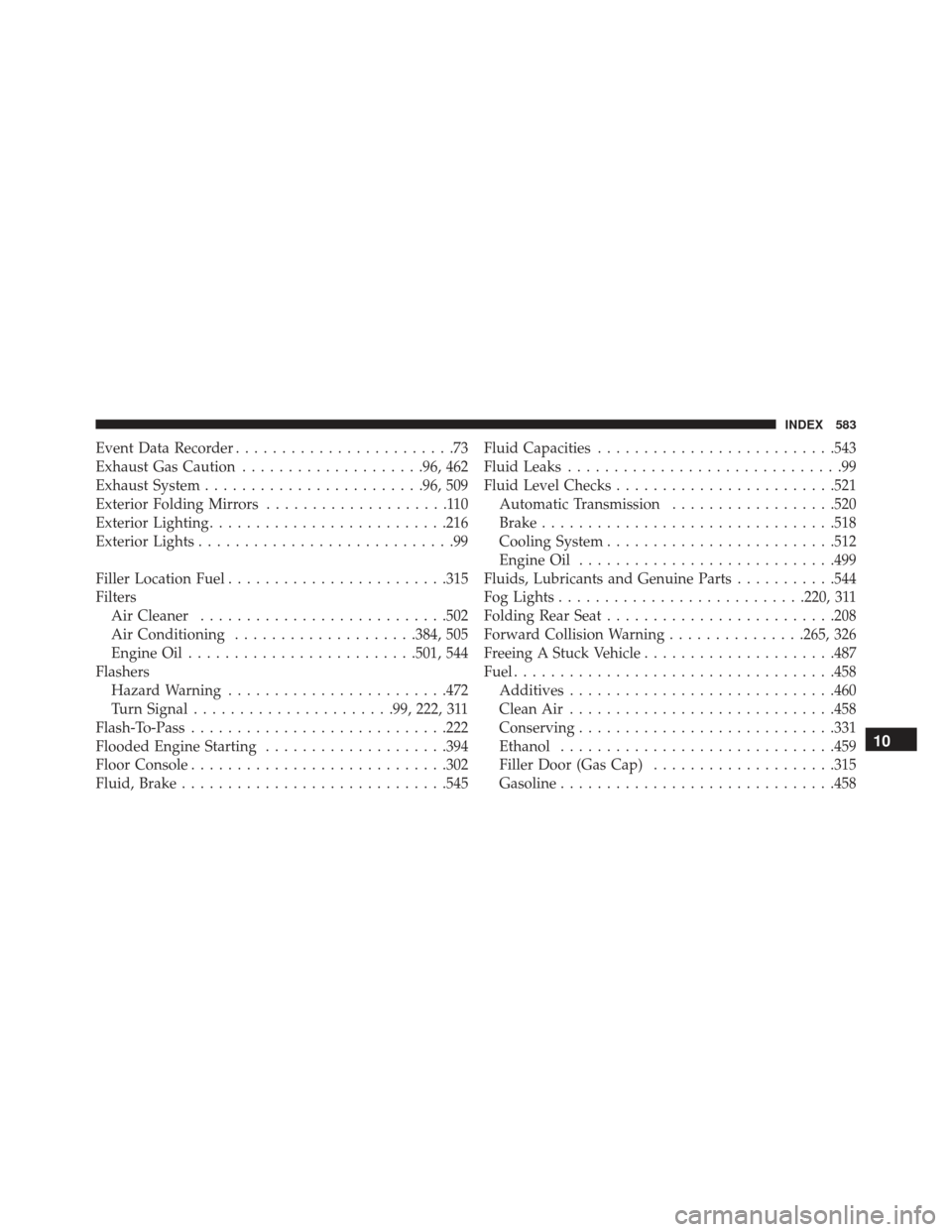
Event Data Recorder........................73
Exhaust Gas Caution ....................96, 462
Exhaust System ....................... .96, 509
Exterior Folding Mirrors ....................110
Exterior Lighting ......................... .216
Exterior Lights ............................99
Filler Location Fuel ....................... .315
Filters Air Cleaner .......................... .502
Air Conditioning ....................384, 505
Engine Oil ........................ .501, 544
Flashers Hazard Warning ....................... .472
Turn Signal ..................... .99, 222, 311
Flash-To-Pass ........................... .222
Flooded Engine Starting ....................394
Floor Console ........................... .302
Fluid, Brake ............................ .545Fluid Capacities
......................... .543
Fluid Leaks ..............................99
Fluid Level Checks ....................... .521
Automatic Transmission ..................520
Brake ............................... .518
Cooling System ........................ .512
Engine Oil ........................... .499
Fluids, Lubricants and Genuine Parts ...........544
Fog Lights .......................... .220, 311
Folding Rear Seat ........................ .208
Forward Collision Warning ...............265, 326
Freeing A Stuck Vehicle .....................487
Fuel .................................. .458
Additives ............................ .460
Clean Air ............................ .458
Conserving ........................... .331
Ethanol ............................. .459
Filler Door (Gas Cap) ....................315
Gasoline ............................. .458
10
INDEX 583